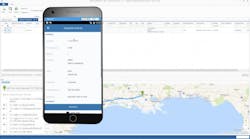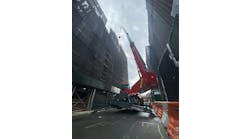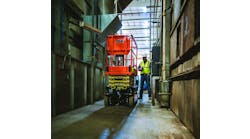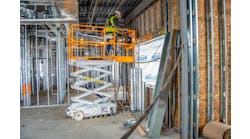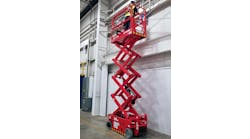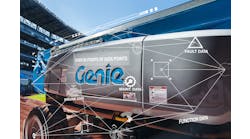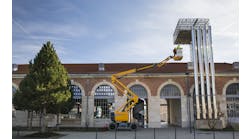Interviews with Software Manufacturers: Logistics Mission Critical
RER interviews several leading software manufacturers about software trends in managing logistics, increasing automation, growing customer ability to manage accounts, the power of the cloud, future rental software developments and more.
The Participants:
Kara Lawrence and Mary Crosslin, co-owners, Alert Management Systems;
Patrice Boivin, president & CEO, Orion Software;
Marc Tedeschi, general manager U.S., inspHire;
Greg Bennett, director of sales, Point-of-Rental Software;
Adrian Aucoin, business development and senior project manager, Corporate Services.
RER: Some of the most important capabilities that have developed recently are in the logistics area, such as mobile apps, viewing fleet location in real time, being able to inform customers about the proximity of a delivery. Do you offer these types of features and what else is on the horizon?
Kara Lawrence and Mary Crosslin: Alert EasyPro has mobile reports that can be accessed on a smartphone, tablet or laptop, to facilitate outside sales and their ability to answer real-time questions for clients. We have created a graphical Dispatch Dashboard with integration to Fleetmatics for delivery dispatching, as well as several telematics interfaces that will manage your rental fleet via GPS. You can update drivers with an email, re-send updated delivery docs, re-route your driver on the fly or take pictures that will automatically attach to the delivery or pickup order.
Mobile Inventory Manager has been a popular feature in Alert for taking inventory (both sales and rental) on mobile devices, as well.
On the horizon: mobile timecard and mobile check-in.
Boivin: Orion has been a pioneer in using mobile applications in logistics management using the GPS location of the mobile devices instead of installing a GPS device in each truck. This innovation allows rental companies to not only save money but be more flexible in managing their fleet. The device can be used by any driver to select a truck or sub-contractors to integrate the fleet. This approach helps us managing both the driver and the fleet. For companies offering on-site services, the same device can be used to do field services. The key in logistic management is to have a complete fleet on the map. During peak period, rental companies use more third party trucking companies or rent trucks to complete their fleet. This resolves that problem by integrating a new truck with just a new mobile application instead of a full expensive GPS device. Route map on the mobile app and warning of delivery time are increasing customer satisfaction.
Tedeschi: Every rental company has some operational elements and they can be amongst its most expensive outlay, so it’s important they are managed correctly to enhance the company’s service as well as improve business efficiencies and reduce costs. Optimizing logistics will empower a profitable, reliable and trusted rental business.
Integrating your logistics management software with a mobile app can be extremely beneficial to a rental business. Having a seamless link between planned deliveries, collections or exchanges and what is happening out on the road can enable companies to give customers much more accurate information about the proximity of a delivery. Seamlessly working together, inspHire Mobile integrating with the logistic planning functionality within the inspHire system allows businesses to stay connected with drivers at all times, sending them real time information to a hand-held device as well as pushing live updates back into the inspHire system. Relaying information to the rental desk staff such as when jobs are completed, a driver arrives on site and the time they left.
This powerful new feature also makes it incredibly easy to see driver’s availability and amend schedules when necessary. Having the ability to collect equipment as soon as a contract has ended maximizes utilization. If a collection is added to the list of jobs they need to complete that day, they will receive a notification that includes details of where they need to go, what they’re collecting and what they are expected to do. From here they will be able to tap the address within the mobile app and Google Maps integration will provide them with directions to the location.
This unified functionality will dramatically improve how teams communicate. Businesses will no longer need to wait for drivers to come back to the office before they give them instructions. Time can be managed with more efficiency and drivers can be much more productive, helping rental businesses ensure all their equipment is in the right place at the right time, with all the correct documentation needed.
The new route planning functionality also allows businesses to plan, manage and optimize journeys quickly and easily. With integrated web-based mapping, inspHire gives you the tools to set recurring or one-off site visits, flag equipment due for servicing and calculate travel times.
Having a solution that gives you a clear understanding of where your driver is, when they’ve arrived and what jobs have been completed will improve the service you deliver your customers, the dispatch process as well as allow rental businesses to take on more jobs. Delivering a high-quality service and equipment on time, as promised, will in turn mean customers stay loyal to your company and make repeat purchases.
Bennett: Logistics is mission critical to rental companies, and poor optimization can keep a company from being profitable. As always, the ability to access key performance indicators in real time is a must and accessing that data from one place is just as important. That is why moving forward rental companies are demanding all of this functionality be available and interface with smart phones and tablets, sending auto alerts to customers/vendors with links that provide them with the info that they need in a timely manner. In the future, rental software will need the ability to geofence assets, shut down assets when called off rent, supply hour meter readings, fault codes, and aid in predicting early machine failures. Point of Rental Software already offers these types of features.
Aucoin: Corporate Services currently integrates with various industry partners capable of delivering real time equipment and delivery notifications. Our mobile application also allows drivers to automatically note delivery details and get customer acceptance signature directly from their connected smart devices. Our mobile dispatch capability is generating high demand, and we are constantly improving and expanding its feature set.
Customers increasingly want to manage their own rentals online, access their accounts, be able to take care of business online, especially using a mobile app. Are you offering these types of services and what new developments will be coming along in this area?
Boivin: In 2014, we implemented our first outsourcing web portal for companies managing assets on behalf of their own customers. We now have a mobile app for on-site management of the rental fleet. Customers can view all their assets by site, order new equipment, take pictures, sign contracts or request an off-rent. We believe that rental companies will gain trust from customers and rent more by giving them better control of their assets. End-users always have the choice to buy or rent. If they choose to rent, they want to make sure it's under control. By offering end customers a better management control tool, it will encourage them to select a single source. This will be a game changer in the next few years as end customers will turn to rental companies to choose their single source for years to come.
Tedeschi: inspHire has recently re-released its new WebPortal solution that helps businesses provide a better customer experience. inspHire WebPortal gives rental businesses’ customers the ability to self-serve 24/7, no matter where they are, online, using a hand-held device. Customers can access important account information such as the equipment they have on rent, copy of invoices, equipment specifications and certifications as well as a full archive of contract history. Another exciting feature allows customers to request equipment through a product catalog and if circumstances change, they have the ability to either extend or end their contract. Customers can also access key account information and run their own reports, such as; ‘what’s out where’, ‘contract status’ and ‘contracts due to end’ reports giving customer more control and allowing them to regularly inform you if the status of equipment needs to change.
inspHire will continue to develop our WebPortal solution to provide customers further control and power to retrieve almost any information they need. We aim to improve the relationship between businesses and their customer, it is important that they can engage with a company in their own time at their own convenience.
Bennett: Today, Point of Rental offers the ability to review rental contracts, request equipment, call equipment off rent, request repairs to equipment (rental and owned), request quotes, disputes, and payments online. We understand that not all rental work takes place behind the counter so our Mobile Workforce app keeps remote employees connected. With Mobile Workforce, employees can access routes, record signatures on delivery, track maintenance, take on-site photos and clock in or out with any device.
Aucoin: We have built customer web portals that allow them to see and organize all open rentals, investigate open invoices, as well as see inventory availability. At this point most of our mobile development has been focused on increasing efficiency and accuracy by streamlining as much of the work flow as possible via our mobile applications.
Lawrence, Crosslin: Absolutely! Alert has been on the cutting edge in this area. We’ve offered both WebRequests and Customer Portal for years. Customer Portal allows clients to access their accounts, re-print invoices and make payments via a login to the store's website. WebRequests provides a 24/7 client-facing sales opportunity for stores to handle rental requests (web order processing) via their website. Both of these solutions are offered in such a way that our clients can own/control their own website and develop the look and feel with web developers of their choice, so each website can be uniquely designed with our clients’ vision and branding in mind.
We were also first to the market with Sign & Rent, a unique mobile app that allows drivers to get electronic signatures, do count sheets, take photos and make notes, all of which will be automatically uploaded to Alert and attached to the ticket that it references. That same app allows clients to sign bids on their laptop or smart device, make payments (which can automatically convert an order to a reservation in Alert), capture electronic signatures at the counter on a tablet, and much more!
Coming soon, Alert is deploying an eCommerce solution where clients will be able to completely manage their own rental experience from start to finish, without ever having to require assistance from the store.
What do you expect will be the most important development/trend in the coming year or so – in rental software in general as well as your company?
Tedeschi: Technology dominates today’s society and that’s mainly down to mobile devices and the internet. Both have made information accessible anytime, anywhere – people are becoming accustomed to having what they want on demand. Therefore, rental businesses want the power to retrieve almost any information and communicate in many ways, all at the click of a button, using a hand-held device. They want information to be easily available and I therefore expect to see some major advancements in both cloud technology and mobile applications this year.
Automation will continue to be a huge trend in 2017. Companies that are able to automate processes will save both time and money. inspHire already offers tools to automate many parts of the rental process so that there is minimal to no human intervention needed. Solutions include workflows for Accounts Payable (AP) and Accounts Receivable (AR) which enable a fast, efficient and reliable process on a mass scale, creating and sending key documentation automatically.
Mobile technology has become incredibly important to many rental businesses, with some even moving to become a paperless operation. inspHire Mobile provides businesses with the features they need to better manage rental, sales and service, when they’re away from the rental desk, out on site, or in the yard, online or offline. Whether its allocating equipment to a contract, counting inventory, servicing and repairing equipment or carrying out tests and inspections, inspHire Mobile does it all.
Bennett: The most important trend in the coming year or so will be mobile apps and integration with third party providers. These are things that are hot buttons in today’s market and this will continue because customers want one access point for information and IU is critical when dealing with a large number of job functions in an organization.
Aucoin: The increased push towards a more ecommerce type rental process will change the landscape of billing automation. Clients want to be able to look up available equipment, schedule rentals, request equipment pickups, and pay invoices…all without having to get on the phone and “waste time.” I think the pace of business and the overall “connectedness” of rental companies, and by extension the software providers will be an exciting trend to witness.
Lawrence, Crosslin: Our vision of rental software trends in the short-term: Alert Management Systems is spending an equal amount of our development resources enhancing existing functionality within Alert EasyPro, as we are adding new functionality altogether. One example is an auto-close option that will interface with our QuickCheck feature. Soon, in addition to being able to scan the barcode on a ticket to check the items in and auto-print count sheets, you will have the option to auto-close invoices that meet a specific set of criteria.
There is a growing interest in RFID for asset management, and Alert is partnering with an RFID company to interface with that technology. We expect that as RFID technology becomes more cost-effective, the uses for RFID tags will become more diverse.
Another project that we are excited about this year is Job Costing that will be built into Alert EasyPro at the ticket level. As more clients become consolidators themselves, or simply expand their operations, it becomes increasingly important that they have a grasp on the profitability of their jobs at a glance. We are hoping to make that easier/faster for our clients with this powerful new tool.
What do we see as the trend for rental software, in general? We feel that the trend that our founder put in place more than 30 years ago will quickly become the norm rather than the exception: allowing client-based user groups to drive development. We are celebrating our 32nd annual International Alert Users' Association meeting this November. When Alert started the multi-day conference, it was unheard of for software companies to take direction from end-users, but now, it's a trend others are following.
What trends do we see for our own company in the coming year? Our company will be bucking the trend of software consolidation. We believe that competition in rental software improves all of our products and makes it a more end-user focused marketplace.
We bought Alert last year, having been long-term employees and members of the board of directors. This next year will see us continue to be focused on and implementing changes to our organization that make it a more fun/creative place to work: flexible hours, telecommuting, collaborative work space, new tech tools. We want to continue to attract new talent while we retain the people that have made Alert Management Systems such an outstanding company to work for over 40+ years.
Boivin: Inter-active Web portal and mobile app where customers can view their transactions, order new equipment and request for off-rent. Providing a full control over the end customer’s equipment rented will be crucial. There is not a month that passes without news that a brick-and-mortar business disappeared because it has not adapted to the Internet. In the next coming years, the larger customers will require a web portal to do business with a rental company. It will be a must and it will come very soon. They will displace their sourcing to the rental companies that have one. This is by far the most important change coming.
Have you made any further developments in CRM-related software? How can your software help customers with this important area?
Bennett: Point of Rental has developed an in house CRM that has not been released to the market to date but it is designed with rental companies in mind.
Aucoin: We have some core CRM functionality for prospecting, follow-ups, and collections activities. We have integrated with numerous CRM partners to give our customers the capabilities they need without having to re-invent the wheel in our solution if the client needs features not currently offered.
Lawrence, Crosslin: Yes! Alert is partnering with CRM software Zoho. Our clients are eager to work with this affordable/scalable solution, and it will allow them to better manage their sales cycle and maintain better sales metrics with this integration.
Boivin: At Orion, we decided to offer a Rental CRM to our customers many years ago because we believe renting is fundamentally different than selling. In rental, you need availability, pricing and quoting to be an integral part of your rental CRM. To maximize the rental of existing assets, add value in the process and develop a trusting relationship with the end customers. Salesmen need to be very responsive and be able to commit in minutes. This way, they maximize the day’s utilization instead of constantly adding to the fleet equipment that will not earn a sufficient ROI in the long run.
Tedeschi: We have seen a huge increase in the number of companies using our CRM solution. Rental businesses recognize that the service they deliver plays a fundamental role in their success and that customers are essential to their future growth. A powerful CRM system that brings together sales, service and marketing, creating a hub of information will allow companies to focus their attention on certain customers, maintain long-term relationships and address the current and future requirements of the industry.
New integration with Mailchimp, innovative email marketing tool lets businesses: build highly targeted email lists, send tailored email marketing campaigns and evaluate campaign performance. Joining the dots, inspHire CRM and Mailchimp aligns your sales and marketing teams to ensure you're contacting the right people at the right time with all the necessary information needed to close the deal. Being prepared and having the information to connect with prospects faster, means you can fill your pipeline with quality leads and make the most of every customer interaction.
Built-in reports allow sales teams to analyze open, click, bounce and unsubscribe rates, giving them the knowledge needed to prioritize calls, cleanse data and make informed sales decisions.
Rental companies are more interested in using analytics to improve their businesses. Are there any particular ways you are able to help in this area – any particular new reports or capabilities?
Aucoin: We spotted and reacted to the increased analytics needs two to three years ago by offering our clients custom reporting and analytic solutions. We have an in-house Crystal Reports style editor that some clients leverage for simple needs. Above that we have a reporting team that can assist in creating custom solutions from a standard tabular report, to scheduled reports and dashboards, custom data warehousing solutions, all the way up to the latest in PowerBI solutions. We have an online demo of some of our reporting solutions available at http://bit.ly/2e7dFlH.
Lawrence, Crosslin: With over 500 canned reports in the Alert EasyPro system, nearly every measure is readily available, and every report can be displayed in Excel with a single click. Our built-in business intelligence tool allows for easy modification of existing reports or the creation of new reports. Many of our report-savvy users have dreamed up even more reports that are available to other users free of charge on our on-line knowledge base.
For even more advanced analytics, we offer an Excel plug-in called Data Pump. The Alert user is able to, with the push of a button, populate an Excel spreadsheet with pre-determined fields to make reporting simpler than ever.
Boivin: At Orion, we developed a four quadrants analysis of the fleet return. Rental companies can quickly assess the type of equipment they own and decide which one to buy more or dispose. For pricing, a comparison to benchmark prices is helping rental companies to understand the results of their fleet and take advantage of opportunities.
Tedeschi: It’s important that businesses have the data they need to learn, refine and optimize everything they do. They want to run reports whenever they need to and customize them to show the information required to make important decisions that will positively impact their business.
With numerous reports built in as standard from operational, financial to business critical and powerful business intelligence dashboards displaying real-time data in an easy to digest format, inspHire lets businesses see at a glance how they are performing on a weekly, monthly or annual basis – they have access to more data than ever before. Key analytics reports including income, future invoiced, ROI and asset analysis highlight trends, helping businesses identify patterns and forecast opportunities.
Bennett: Point of Rental Software uses Microsoft Power BI which pulls data from multiple data bases giving rental companies improved analytics.
How can your software help with fleet management, i.e., knowing how long equipment should be kept or knowing when it is more economic to replace equipment?
Lawrence, Crosslin: Fleet Management is a key reason to own rental software, not just to accurately reflect availability, but to track expenses, additional purchase costs, ROI and utilization. Alert has been helping its clients do that since 1976 with Work Order & Preventive Maintenance, rolling 12-month utilization reports, on-yard reports, target ROI & disposal dates, and more. Our partnerships with several of the leading telematics companies also allow our clients to use GPS to locate & control their equipment in the field, build geo-fences, ping for meter readings (which then feed into our Preventive Maintenance system), and more.
Boivin: We offer a set of reports and graphs to assess the pattern of asset performance to indicate if it's time to dispose of or keep them. A fully cost ROI including the preventive maintenance is offering a better indicator for assets requiring higher maintenance costs and sliding toward the assets to dispose quadrant.
Tedeschi: We understand that having access to insightful data about how your equipment is performing is also important. It helps rental businesses make educated decisions about what equipment should be kept or replaced. inspHire captures all the important information needed to analyze the performance of equipment including the cost of services and repairs. Utilizing inspHire’s asset analysis report will highlight what equipment is making or costing businesses the most, what the average turnaround is for a service or breakdown and when it is more economic to replace equipment.
Bennett: We track a lot of information about individual assets like repair history, ROI, revenue, time utilization, seasonality, purchase cost, and depreciation. All of this information plays a role in setting the bench marks needed for fleet management.
Aucoin: When employing our entire solution, dashboards and reports can be leveraged to let the business owner know when equipment is getting more expensive to maintain than it has in the past by spotting trends. You can look at these types of details on a unit level P&L level, a customer-centric rental history effect, and any others that we can turn the data you’re collecting into actionable data for your business.
How is your software updating and simplifying the rental transaction?
Boivin: From its inception, the Sirius e platform was designed to provide the most user friendly rental solutions to end-users. For us, simplicity is more than just a few less clicks, it’s to provide all information in a very concise way in order to take quick and informed decisions. That’s why we use actionable graphs, calendar and maps to present a full picture of the availability status, sub-rent equipment, transfer to other branches, book field technicians or dispatch delivery fleet. With easy to read graphical interface, users can take informed decision faster leading to more efficient transaction flow.
Tedeschi: In a busy rental company efficiency is key, so rental management software that allows you to seamlessly convert more quotes to orders with less effort is crucial. Rapid data entry screens in inspHire mean you can quickly enter customer information and allocate items to an order in seconds. Combined with full visibility of where equipment is, when it will be returned and what is available helps users fulfil customer request as quickly as possible.
inspHire WebPortal can also simplify the rental transaction process. Integrating directly with the inspHire system, customers can request equipment and raise partial orders, meaning rental desk staff just need to confirm the request thus, reducing the time they spend entering customer information. When logged in, customers can be shown specific rates and / or equipment availability to make the process even easier and more accurate.
Bennett: With our latest development, Rental eSign, we are helping rental companies go green and eliminate paper contracts. This product has expanded beyond contracts and agreements and can now be used to collect a signature on any document. Initially created to enable rental businesses to send additional agreements, addendums, or waivers, the product is capable of recording signatures on any PDF. It then stores signatures in a searchable database for easy future access.
Aucoin: A new initiative has been in leveraging our new Dispatch Dashboard and Mobile Dispatch to streamline the rental and return workflow. Traditionally paper intensive manual processes can now be electronically captured so that from a business flow you know exactly where in your process you are and have the entire process from customer call to driver delivery digitally captured to provide better data for yourself and a higher quality of service to your clients.
Lawrence, Crosslin: This has become especially critical as rental software has developed into a more complex product, going from a way to write a legible ticket for a client several decades ago to a mission-critical part of the rental operation today, touching every aspect of the organization. We are offering more and more features, conveying more information and interfacing with more third party products than ever before and therefore have added many features to streamline the ticket writing process.
Technology itself has created levels of efficiency, just in ease of processing credit cards, automating billing, recording drivers’ license information, importing to accounting software, etc. But at the heart of it all is ticket writing and even as the options that we present to the rental staff become more complex, the ease with which they can write a ticket must improve. To accomplish this Alert has added a NextStep Navigator to guide new employees through the ticket-writing process, suggested add-on items, automated change notifications, easy to see/use 'Done' and 'Accept' buttons to skip unnecessary fields and we have replaced many reports -- and the need to go to multiple screens -- with easy to use color-coded dashboards.
How is your software helping rental companies to run maintenance and repair more efficiently?
Tedeschi: Complete Workshop functionality within the inspHire system allows rental businesses to manage, the service, maintenance and repair of owned equipment as well as customer’s own equipment. Flag fleet when it is due for service or repair and use checklists within the system or on a hand-held device to ensure jobs are completed to regulation standards.
With advanced mobile technology, rental companies can reap the benefits and manage the maintenance, service and repair of equipment on the go. Users can issue parts, add labor charges and costs, enter meter-based readings, capture customer signatures to sign off damages or repairs as well as capture damage photos. With the tools to process workshop jobs and complete scheduled service, maintenance or repairs from anywhere, online or offline, inspHire Mobile improves the efficiency and productivity of your mobile workforce as well as minimizes breakdowns and maximizes equipment utilization.
The ability to enter test results and create legally binding certification in the yard or warehouse can also massively improve your business efficiencies. Compulsory health and safety checks make sure your equipment is legally compliant at all times with certificates automatically stored back in the inspHire system so documents are there when you need them.
Full ROI reporting means you can analyze costs, margins and profit of each job, down to the individual parts used or employee hours.
Bennett: With our integration with SmartEquip, we’re able to streamline the service process, eliminate parts orders errors, and increase a store’s rental fleet utilization. Utilizing this integration, purchase orders and work orders are automatically and accurately populated. Plus, you can receive self-updating parts, service and repair information dynamically customized down to the individual asset number for equipment in your fleet, saving a lot of time and money.
In addition to this integration, our Inspection App allows managers to create templates that include standard inspection requirements, eliminating the need for paper checklists and allowing all inspection information to be easily sorted and accessed by the people who need it. If a high-priority task doesn’t pass inspection, a repair order will automatically be generated, the item gets removed from inventory, and maintenance can get to work repairing it. You can create inspections for each level of maintenance as well, so your mechanic knows exactly what needs to be done on the 500-hour maintenance.
Aucoin: Our Maintenance Module is fully integrated into our solution, not only will you get full repair and service history in a single place (including outside services), but it also allows you to augment your rental process by including surcharges for allowable usage, mileage/meter based interim billings for long term rentals, as well as the ability to drive assets directly to repair as a result of customer damage. Utilizing our Maintenance Module along with our mobile application allows you to streamline the entry of data and time collection by having your technician’s complete tasks, track time, and consume parts using their smart devices or devices staged in the repair shop. This can give you much more accurate records as well as enabling you to start drilling down into shop efficiency metrics to further improve your operation.
Lawrence, Crosslin: Our Work Order and Preventive Maintenance Systems were at one time used primarily by equipment stores, but now event companies also see the benefit to tracking internal repair costs, knowing when units are down for maintenance, whether equipment is hard or soft down, and when scheduled preventive maintenance needs to be done. It is true for all industries, better to schedule down-time than have it thrust upon you at an unfortunate time -- and let's face it, any time you don’t expect equipment to be down is unfortunate!
Our Work Order Generator makes it especially easy to handle the creation of Works Orders, it will automatically create a Work Order or prompt you whether you want one created under a series of conditions (i.e. a preventive maintenance trigger or an exchange of units). It is just one example of how we try to eliminate touch-costs from our client's business. Further, the Work Order and Fixed Asset Dashboards allow you to get a visual of where units are, what projected repair times are or how long units are taking to get repaired.
Boivin: We offer calendar and maps to schedule shop repairs and field technicians. In a rental companies, there are often resources involved in both and that's why our solutions offer a mix of internal and field repairs. We want to continue to invest in the efficiency of the repair where there are significant gains to get.
Do you expect to see further developments in terms of Cloud technology and SaaS?
Bennett: Cloud technology is constantly improving and as we watch the industry leaders like Google and Apple, we can see what internet delivered technology will look like in the future. Point of Rental is constantly innovating on behalf of our customers and trying to deliver tools that enhance rental store productivity. Our software is developed on a modern software platform which allows us to be flexible and more easily take advantage of new advancements as they are made.
Aucoin: We believe that Cloud deployment and SaaS are here to stay and relatively mature. There may be some improvements to streamline time to market for some solutions, but in the coming years we think 60 to 75 percent of all of our implementations will occur in a cloud environment as IT departments realize all of the benefits of offloading operational and accounting systems off of costly hardware in the office and move into the cloud age.
Lawrence, Crosslin: Alert and the rental software industry in general has been offering both Cloud Hosting and SaaS (software as a service) since the 90's, but rental stores have always been wary about 'renting' software -- they know that there is profit in renting things, so they are not eager to do so themselves. While SaaS gets bantered about & often gets asked about by the IT people helping make a software buying decision, rarely do rental stores choose that option. They prefer to own their software licenses.
As rental store owners have become more comfortable with the concept of Cloud Computing, we have seen an increased demand/level of interest. What seems to have changed is that stores are much more aware of their dependency on their rental software and their tolerance for down-time is much less than it was even a decade ago. Stores are examining overhead costs and like the idea of having servers constantly updated, anti-virus and backups managed for them, and the ease with which they can scale-up (users/CPU/RAM/etc.). It not only limits their need for expensive IT contract services, but it puts their expenses in a predictable and easy-to-budget format. We find that with each passing year, the reticence to have their data off-site and not 'in their control' is being replaced with the desire for it to be secure, redundantly backed up, not subject to environmental threats, and accessible by multiple locations quickly/easily.
Boivin: As the web base programming languages are improving, the rental applications will be moving toward web base interface and Orion is offering, today a combination of both. For heavy users that require more complete and interactive solution, we have a Windows application and the lighter users are using web base interface or mobile application. In fact, users can operate most of their operations on a mobile application if they chose to. There is no reason for that trend to stop. In the end, cloud and SaaS users will continue to grow with less complexity.
Tedeschi: It’s no surprise that cloud technology has revolutionized the way rental companies do business. It is expected that this rise is to continue as many businesses see the benefits of no installation or maintenance and low monthly costs very attractive. Conversely, further development to make cloud based rental management systems more mature, stable and feature rich is vital for the trend to continue and have a positive effect on larger, corporate organizations. Currently, cloud technology and SaaS (Software as a Service) is most popular amongst small to mid-sized businesses who have less specialized needs and who are attracted by the low cost initial investment. The small entry cost of cloud based software and SaaS is part of the reason for their widespread adoption. Nerveless, the cost over time will balance and implementing a multi-tenanted platform is the key to bringing costs down.
Having the ability to retrieve information wherever and whenever, is another reason why cloud technology is so popular. The cloud enables teams to coordinate via the web across different platforms. However, embracing a sophisticated ‘hybrid solution’ that combines well developed on premise software, with advanced mobile technology and online functionality, provides rental businesses with a feature rich solution that makes information accessible anywhere, anytime. A solution like this, that connects systems that constantly talk to each other, still gives users access to the same information without the need to compromise on functionality.
